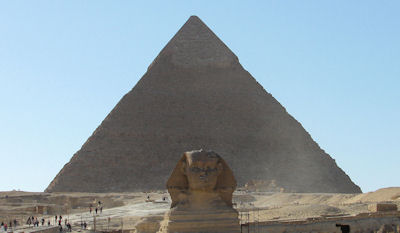

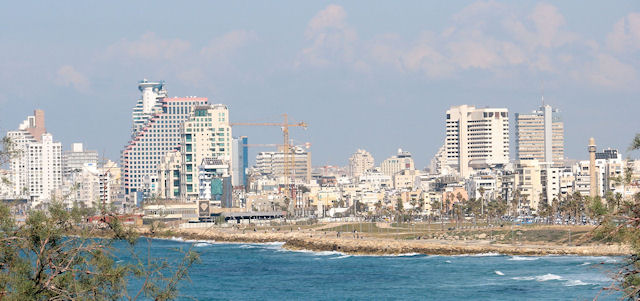 | Our first stop was Tel Aviv, a modern prelude to a trip dominated by antiquities. |
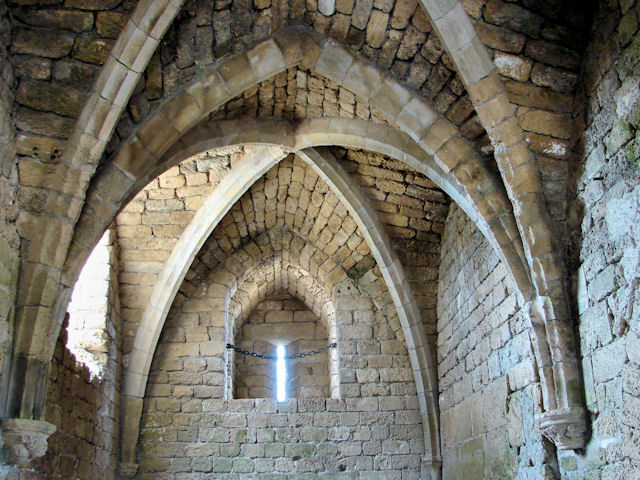 | From
Tel Aviv, we motor coached to Caesarea, an archaeological site that has
been turned into a national park, adjacent to a very fine housing
development. This has all come from Rothschild money. Caesarea was developed by Herod I (Herod the Great) as a seaport starting in about 22 BC, but it was occupied by the Roman Romans, by the Byzantine Romans, by the Islamic Empire, by the Crusaders and by the Mamluks, who razed most of the fortifications. Today's Caesarea is accessed through gates built by the Crusaders. |
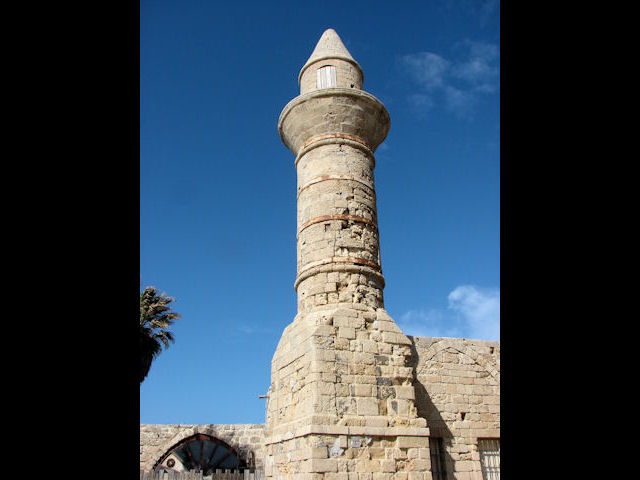 | The
rediscovery of Caesarea was more or less started in the Bosnian
refugees, who settled here in the 1870's and 1880's. From the
time of the Mamluks destruction, the town had remained in ruins.
This minaret really dates to the 19th century, pretty new
for an antiquity. |
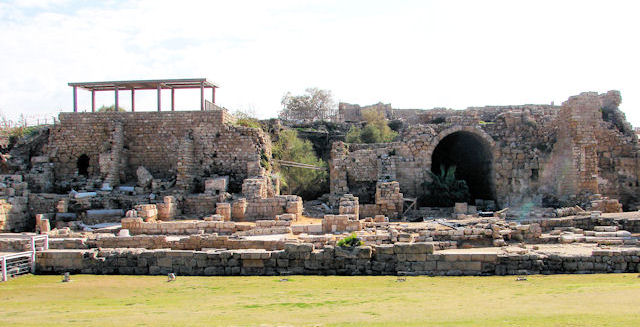 | This
is the original pier, with warehouses, and there was a temple to Caesar
Augustus where the little pavilion now sits. Under the
Byzantines, the temple to Caesar was replaced by a Christian church. The port silted
up, so the grass would have been salt water during Caesarea's heyday. |
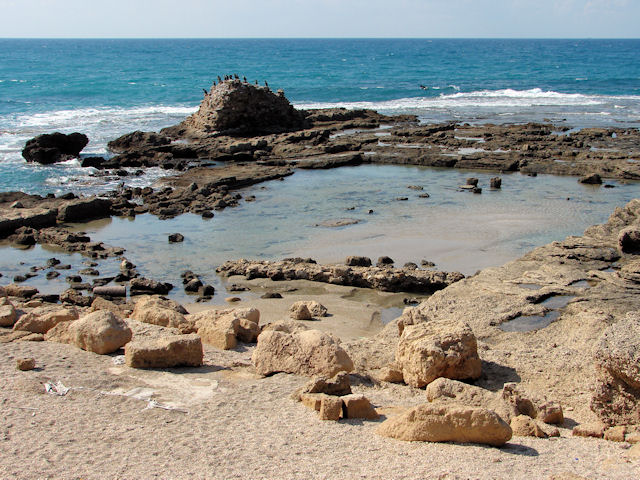 | Recently, they have uncovered the promontory palace that Herod built, and on the lower level, we see his sea-water pool. The Caesarea site includes a theater, an amphitheater overlooking the Mediterranean Sea, and a hippodrome, as well as assorted palaces and other residences. (Now restaurants and gift shops, of course.) |
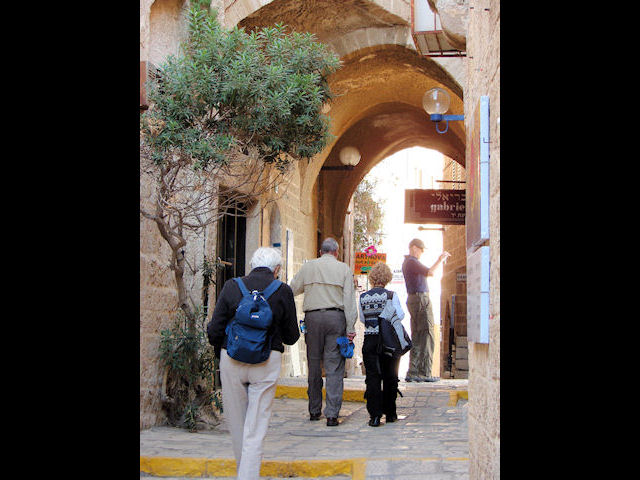 | Old
Jaffa has probably been in continuous operation as a port longer than
any other in the world.
It is part of Tel Aviv now, and it has become an arts and
entertainment quarter. Plus a lot churches, mosques, and
synagogues. |
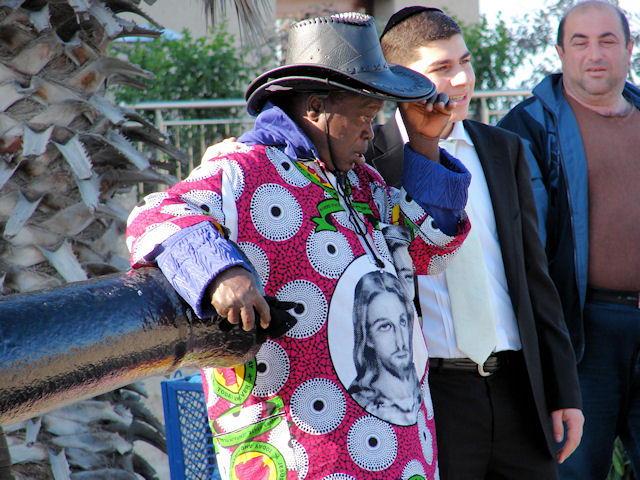 | Jaffa is a magnet for pilgrims. This one is from Nigeria, and his mission is two-fold, as a pilgrim and as a pan-handler. The cannon he is leaning on was left by Napoleon, when his forces departed in 1814. The Bosnian governor of Acre had laid siege to Jaffa and prevailed after 9 months. Napoleon didn't win them all. |
The
city of Maresha recurs throughout the Old Testament, but it was finally
destroyed in about 40 BCE. What is left now is the hill called a
tell, that marks the location of the ruins. The big attraction of
Tel Maresha is its complex of caves. These caves were work rooms
for the residents, but in about 200 BCE, under yet another attack, the
residents dumped every thing in the caves and ran. Now these caves are an
archaeological treasure trove,. | |
Archaeological
Seminars Ltd. is managing the excavation of Tel Maresha, and they use
paying visitors to do a lot of the digging. As you see here. | |
One
of the caves proved to be an olive oil factory, with this olive oil
mill, oil presses and storage spaces carved into the stone. It
appears that this particular workshop went into disuse and became a
stone quarry. | |
In
the 1960's, the owner of the Holyland Hotel in Jerusalem, with the
help of a dedicated professor, constructed a scale (1:50) model of
Jerusalem as it would have been seen in the time of the Second Temple.
This is the Jerusalem that Jesus would have walked though, even
though the nominal date is 66 CE. Among the buildings, one can
find the palaces occupied by both Herod and Caiaphas. The Temple
Mount is obvious on the right hand side of this picture. The gorge on the right hand side of the model is the Kidron Valley. It will crop up again, below. The model has been moved from the Holyland Hotel to the Israel Museum, where it is just steps from the Dead Sea Scrolls. | |
Solomon
built the "First Temple" on Mt. Moriah in Jerusalem, but it was
destroyed in 586 BCE. When the Jews returned from exile in
Babylon, they built the "Second Temple" on Mt. Moriah, dedicating it in
515 BCE. Starting in about 19 BCE, Herod
the Great built an elegant
expansion to the original second temple. Mt. Moriah had some steep slopes, and Herod's remodel job included terracing and filling the mountain top to form the large square terrace we see today. Besides the written records, archeology has confirmed the gold embellishment of Herod's Temple, which was mostly marble, not a local stone. So it looked just like this! | |
The
Dome of the Rock was built on the site of the Second Temple, although
temple itself was mostly destroyed by Emperor Titus in 70 CE. The Dome of the Rock was built between 687 and 691 CE. This view is actually from near the top of the Mount of Olives. | |
This
longer view, still from the Mount of Olives, shows how Herod the Great
terraced the top of Mt. Moriah, roughly 1600 feet (left and right in
this picture) by 900 feet. The Al Aqsa Mosque occupies the left
rear corner of Temple Mount, but this structure is just the latest of a
dozen or so reconstructions since the Prophet Mohammed's time.
The date of the original prayer house is lost. The foreground of this picture is a Jewish cemetery. There is a Muslim cemetery just this side of the eastern wall of Temple Mount. | |
The Garden of Gesthemane is located at the base of the Mount of Olives, in the Valley of Kidron.
Gesthemane translated to "olive press," so these old olive trees
should be no surprise. These are old, but probably not 2000 years old. | |
Most
of the holy sites in and around the Garden of Gesthemane have been
enclosed within the Church of All Nations. This 1922 construction
replaces a Byzantine church and a Crusader church, destroyed in 746 CE
and 1219 CE respectively. | |
Old
Jerusalem was a walled city, of course. This is the Zion Gate,
facing Mount Zion to the west of the old city. Mount Zion, in the
time of the Second Temple, was actually a pretty classy residential
area. The palaces of both Caiaphas and Herod were near the top of
Mount Zion. | |
We
have to remember that Jerusalem was a Roman city The city was
razed and reconceived as a secular city by Hadrian in 135 CE, and it stayed that way until
the Byzantine Empire was established. Every Roman city
had its "cardo," a main shopping street. In Jerusalem, Cardo
Maximus was 40 feet wide, with columns on each side. Beyond the
columns were all the shops. This portion of the Cardo was
excavated in the 1970's. | |
The
Church of the Holy Sepulcher, as seen today is the product a dozens of
rebuilds over the years. Of course, the Jerusalem Christians had
a shrine at the Holy Sepulcher until Hadrian buried it, as part of his
secularization campaign in 135 CE. Constantinople revived the
site, and from the 4th Century on, it was a pilgrimage destination.
Caliphs and fire and earthquakes all played their roles in
remodeling the Holy Sepulcher over the years. Since it is located on the sites of Jesus crucifixion and burial, this site could not have been within the city walls. The rule was "No tombs in the city!" The city walls were extended, however, at a later date. While this is the entry to a Greek Orthodox church, the ownership of the doors rests with two Muslim families, by authority of Saladin in 1192. | |
The
Holy Sepulcher is a complex, occupied by seven or eight Christian
religious groups. This is a portion of the Ethiopian Orthodox
monastery on the site. | |
The
Church of the Holy Sepulcher itself is the seat of the Greek Orthodox
Patriarch of Jerusalem. This is a reasonable heritage from the
Byzantine reconstruction of the church, but one that has been challenged over the years, particularly by the Franciscans. | |
Just inside the door, the Anointing Stone sits beneath an array of lanterns. | |
The
entry to the Holy Tomb itself. This is a tiny narrow tunnel,
leading to a room about 5' by 7'. There are relics lining the
walls on the way in. | |
The
Western Wall of Temple Mount is a site of reverence for all Jews.
This wall has been damaged and rebuilt, like most everything
in ancient Jerusalem. Within the wall, you can identify the stones
that were originally quarried by Herod the Great. The brownish fence separates the Western Wall into a zone for men and a much smaller zone for women. In fact, there is a huge enclosed region in the men's zone, which has altars and a library. | |
Herod
the Great was a builder. He created Masada, a fortified palace on this
mountain overlooking the Dead Sea. It was fitted with cisterns
and food storage rooms. It also had a Roman bath, with
a tepidarium and a caldarium. The frigidarium may have been lost. | |
Masada
was probably not a very important palace for Herod, in part because it
was a long way out of town. It became important in 66 CE,
when a group of Jews known as the Sicarii overcame the Roman guards and
took up residence in Masada. From this vantage point, they are
said to have carried out raids against the Romans, who were involved in
a war against the Jews that had started with the Jewish revolt in 66 CE. A second group joined the Sicarii in 70 CE, around the time the Second Temple was destroyed. The total group totaled just less than a thousand. | |
The
pattern on the ground is the command camp of the Roman Tenth
Legion, roughly 10,000 men. It was commanded by Lucius
Flavius Silva, and in his camp was the historian Josephus, whose
reports are key to our knowledge of what happened in her. There
were seven other camps surrounding the mountain. In 73 CE, after figuring out that the Jews didn't lack either food or water, the Romans built a ramp to assault the mountain with their siege engine. An effort to burn the gate set their siege engine on fire, but the gate was seriously damaged. When Lucius Flavius Silva got in, virtually all the inhabitants were dead, sort of a Jonestown story. | |
Beyond
the buttes, you can see the Dead Sea, and beyond it the mountains of
the Jordan desert. Unfortunately, the Dead Sea is shrinking.
There is too much demand for water from the Jordan River, which
feeds the Dead Sea. | |
You
can see that the smart ones are wearing footwear. The Dead Sea
beach is made up of crystals of rock salt, with sharp edges. Not
nice for your feet. The cast here are three of our fellow
travelers. We
neglected to pack swim suits, unfortunately. |
| Return to Home Page | Navigate to Next Page |